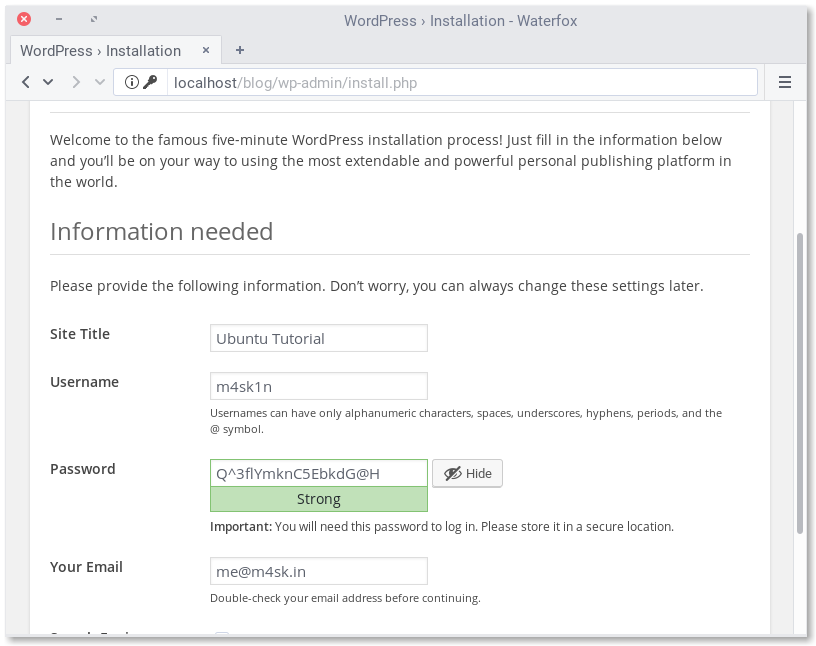WordPress Local and Debugging

WordPress is a powerful and the most popular content management system (CMS) that allows you to easily create, manage, and customize websites and blogs. It is an open-source CMS, built on PHP and using either MySQL or MariaDB.
- Released in 2003, initially just for blogging, then evolved into a platform for building websites, online stores, forums, landing pages, etc.
- Today, more than 40% of websites worldwide run on WordPress.
There are two versions of WordPress:
WordPress.com
- Hosting service provided by Automattic
- You just register an account, no installation needed
- Limited customization; advanced features require payment
WordPress.org
- Open source, you download and install it on your own hosting/server
- Fully customizable: install plugins, themes, write code, and build any type of website
1 Ecosystem
- Core: the main CMS
- Plugins: add-on software that extends WordPress functionality with new features
- Themes: add-on software that defines the visual appearance and layout of a WordPress site
2 Why WordPress Hacking?
State of WordPress Security in 2024
2.1 Most Popular
- Currently, more than 40% of websites worldwide run on WordPress
- This means hackers only need to find one common vulnerability => they can exploit millions of sites at once
- Similar to the saying: “fish where the fish are”
2.2 Plugins and Themes
- WordPress Core has been reviewed for a long time by thousands of developers and researchers, making it very difficult for attackers to compromise directly.
- However, there are tens of thousands of plugins and themes from various sources with inconsistent quality.
- Many plugins have poor security coding and are outdated. Hackers just need to scan for outdated versions and exploit them.
3 Setup WordPress for Hacking
There are many ways to set up WordPress; searching Google will provide plenty of guides. Here I will set it up on an Ubuntu (22.04) virtual machine:
- Does not affect real machine services
- WordPress is relatively lightweight and works well on a VM
3.1 Install and Configure WordPress
3.1.1 Install Dependencies
Install the full stack required to run WordPress (web server + database + PHP + important extensions):
sudo apt install -y apache2 \
ghostscript \
libapache2-mod-php \
mysql-server \
php \
php-bcmath \
php-curl \
php-imagick \
php-intl \
php-json \
php-mbstring \
php-mysql \
php-xml \
php-zip3.1.2 Install WordPress
Download and install WordPress source into the web directory:
# Create folder to store site source code
sudo mkdir -p /srv/www
# Change ownership to www-data (default user for Apache/Nginx)
sudo chown www-data: /srv/www
# Download the latest WordPress package and extract it into /srv/www
curl https://wordpress.org/latest.tar.gz | sudo -u www-data tar zx -C /srv/wwwDownload a specific version:
curl https://wordpress.org/wordpress-6.6.2.tar.gz | sudo -u www-data tar zx -C /srv/wwwInstalling from
wordpress.orgis the most reliable and safest approach:
- Ubuntu has a
wordpresspackage in its repository, but it is often outdated compared to the official release.- The WordPress community only supports installations from the official source.
3.1.3 Configure Apache for WordPress
Create & edit /etc/apache2/sites-available/wordpress.conf:
sudo nano /etc/apache2/sites-available/wordpress.confPaste the following content in:
<VirtualHost *:80>
DocumentRoot /srv/www/wordpress
<Directory /srv/www/wordpress>
Options FollowSymLinks
AllowOverride Limit Options FileInfo
DirectoryIndex index.php
Require all granted
</Directory>
<Directory /srv/www/wordpress/wp-content>
Options FollowSymLinks
Require all granted
</Directory>
</VirtualHost>Enable the site:
sudo a2ensite wordpressEnable rewrite module:
sudo a2enmod rewrite(Optional) Disable default site:
sudo a2dissite 000-defaultReload Apache:
sudo service apache2 reload3.1.4 Configure Database
sudo mysql -u rootCREATE DATABASE wordpress;
CREATE USER wordpress@localhost IDENTIFIED BY '<your-password>';
GRANT SELECT,INSERT,UPDATE,DELETE,CREATE,DROP,ALTER ON wordpress.* TO wordpress@localhost;
FLUSH PRIVILEGES;
quitRestart MySQL:
sudo service mysql start3.1.5 Configure WordPress to Connect to the Database
Copy config file:
sudo -u www-data cp /srv/www/wordpress/wp-config-sample.php /srv/www/wordpress/wp-config.phpEdit database info:
sudo -u www-data sed -i 's/database_name_here/wordpress/' /srv/www/wordpress/wp-config.php
sudo -u www-data sed -i 's/username_here/wordpress/' /srv/www/wordpress/wp-config.php
sudo -u www-data sed -i 's/password_here/<your-password>/' /srv/www/wordpress/wp-config.phpAdd secret keys and salts from: https://api.wordpress.org/secret-key/1.1/salt/
sudo nano /srv/www/wordpress/wp-config.php3.1.6 Configure WordPress
Visit http://localhost and set site title, username, password, and admin email.

3.2 Setup Debug on VSCode
3.2.1 Add PHP Debug Extension on VSCode
Go to Extensions (Ctrl+Shift+X) → search PHP Debug (by Felix Becker) → Install.
3.2.2 Install Xdebug on Ubuntu
sudo apt install php-xdebug -yCheck installation:
php -v3.2.3 Configure Xdebug
sudo nano /etc/php/<version>/apache2/php.iniAppend:
zend_extension=xdebug.so
xdebug.mode=debug
xdebug.start_with_request=yes
xdebug.client_host=127.0.0.1
xdebug.client_port=9003Restart Apache:
sudo systemctl restart apache23.2.4 Configure VSCode launch.json
Open WordPress folder in VSCode:
code /srv/www/wordpressCreate .vscode/launch.json:
{
"version": "0.2.0",
"configurations": [
{
"name": "Listen for Xdebug",
"type": "php",
"request": "launch",
"port": 9003,
"pathMappings": {
"/srv/www/wordpress": "${workspaceFolder}"
}
}
]
}4 Extend
4.1 Required Version
Each WordPress version usually requires a specific PHP version. Always check compatibility.
4.2 WordPress Auto Update
Since WordPress 3.7 (2013), WordPress supports automatic background updates for:
- Security releases
- Maintenance releases
- (Major versions require explicit opt-in)
To disable auto updates, add to wp-config.php:
define( 'WP_AUTO_UPDATE_CORE', false );4.3 Increase Plugin Upload Size
Paste below content into php.ini file.
upload_max_filesize = 64M
post_max_size = 64M
memory_limit = 128M
max_execution_time = 300
max_input_time = 300